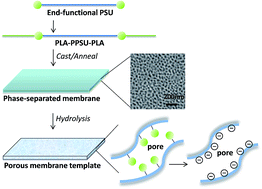Nanoporous polysulfone membranes via a degradable block copolymer precursor for redox flow batteries
Abstract
Nanoporous polysulfone (PSU) membranes were fabricated via post-hydrolysis of polylactide (PLA) from PLA–PSU–PLA triblock copolymer membranes. The PSU scaffold was thermally crosslinked before sacrificing PLA blocks. The resulting nanopore surface was chemically modified with sulfonic acid moieties. The membranes were analyzed and evaluated as separators for vanadium redox flow batteries. Nanoporous PSU membranes prepared by this new method and further chemically modified to a slight degree exhibited unique behavior with respect to their ionic conductivity when exposed to solutions of increasing acid concentration.


 Please wait while we load your content...
Please wait while we load your content...